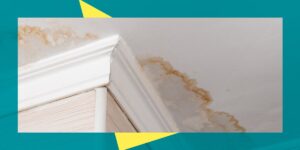 As you look at your home, you may eventually come across signs of water damage. While water may seem like a benign force that we need to consume to survive, even a little bit in the wrong place can lead to serious, expensive consequences.
As you look at your home, you may eventually come across signs of water damage. While water may seem like a benign force that we need to consume to survive, even a little bit in the wrong place can lead to serious, expensive consequences.
You may have a few questions when it comes to water damage. Is this water damage old or new? Does water damage get worse over time? What’s the difference between a fresh water stain on the ceiling and an old stain? Does the age of the water damage even matter? In short, yes. Read on to learn everything you need to know about telling how old your water damage is.
The Risks of Water Damage
First, it’s important to understand the various risks that water damage of any type can pose to your home and even its occupants. Understanding how to tell if water damage is new or old will help you better realize what to look for when surveying for water damage. From there, you can better identify whether the water damage is old or new and what specific risks are potentially present.
Here are some of the risks of water damage:
- Decaying materials: Construction materials and water are two things that should stay apart. Water in the wrong places can lead to rusted metal, decaying wood, bad sheetrock, ruined carpeting and more.
- Unstable foundations: Water leaks can get into a home’s foundation and cause severe damage that put the entire structure at risk. This is especially true when you consider the freeze/thaw cycle that can easily cause foundations to begin cracking, which can let more water in.
- Flooding: Some signs of water damage, even small ones, could actually be visual evidence of leaks. In the worst situations, you could experience flooding that leads to more severe water damage.
- Electrical malfunctions: Water damage can also lead to electrical malfunctions. These can be quite dangerous and inconvenient, as they can contribute to your devices shorting out and may even start an electrical fire.
- Health risks: Left unattended, water damage can lead to mold and algae, which can make you and other occupants experience negative health effects.
When you consider the risks associated with water damage, you can understand why you should be able to identify it. Part of the reason is that fresh water damage may lead to less serious consequences, although this is not always the case. Regardless, the sooner you address your water damage issue, the better your outcome will be.

How to Tell if Water Damage Is New or Old
If you think you see signs of water damage — which you can learn about in greater detail in the next section — you need to first determine how long the damage has been present. Here are some strategies for determining whether water damage is new or old.
Know the Building’s History
Unless your home is brand new, there’s a good chance that many of its components have been repaired or replaced at some point. Repaired or replaced components may include pipes, fixtures and the entire water system. When these components are of different ages, then there’s a higher chance of malfunction, breakage and leaks.
Find out as much information as possible regarding the building’s age and what types of maintenance previous owners have performed. Then, take special care to inspect the areas of the home with the oldest fixtures along with the areas beneath these locations. Look for signs of old, new and potential water damage.
Visually Inspect the Area
If you see a sign of water damage, look for some visual cues that can help you determine its age and severity. Here are some characteristics of water damage to look out for:
- Signs of decay: Peeling paint, bubbling wall materials and discoloration are all signs that the material is suffering from water damage.
- Spots and rings: If you see dark spots or rings on a ceiling, wall or floor, then you can know that water damage has occurred.
- Mold: If you notice the presence of mold in your home, that’s a sure sign that water damage has occurred or is ongoing. Note that mold can spread rapidly throughout a building, so the place where you find mold may be different than the location of the water damage that caused it.
Touch the Water Damage
Touch the water damage if it is safe to do so. Feeling the affected surface can be one of the most revealing actions you can take when inspecting water damage. Does the area feel wet? Is the material hard or soft? Keep these factors in mind during your inspection. In the next section, you can learn more about what the different textures mean in terms of the age of the water damage.
Signs of Water Damage on Ceiling and Walls — Old Water Damage vs New
Once you’ve located the water damage, use the three techniques above to determine its relative age. Your approach to old vs. new water damage may be different depending on the situation.
There are many early signs of water damage on ceilings and walls that you should know about, including the following:
- The area is wet: If the area is wet to the touch, there’s a good chance that the water damage has only recently occurred or is ongoing. The sooner you address it, the better.
- The visible damage is only a small spot: If the discoloration of the water damage is only a small spot, then the damage is relatively young.
- There is little or no discoloration and decay: If you feel wetness but there are no signs of discoloration or decay, you caught the water damage at one of its earliest stages and have a good chance of solving the problem before anything worse happens.
Here are some of the signs of old water damage:
- The area is discolored but dry: One sign of old water damage is the presence of water spots on the ceiling but no leak or wetness.
- Mold is present: It only takes mold 24 to 48 hours to develop after water damage. But mold is often a sign of old water damage, as it can spend days or even weeks in areas that are out of sight before becoming visible.
- There are visible rings: Water stains with rings are a sign that the water damage has aged a bit. The more rings present, the older the damage is.
Call ServiceMaster of Lincoln Park for Water Damage Remediation
Whether you have a brown stain on the ceiling but no leak or visible leaking and flooding, ServiceMaster of Lincoln Park is here to help you throughout Chicago and its suburbs. We offer water damage restoration services and mold remediation services to ensure you can get your life back on track after water damage.
We offer 24/7 emergency service, so contact us today if you need more information or are experiencing water damage.


